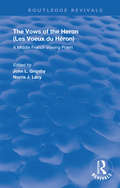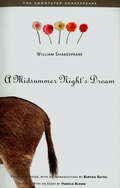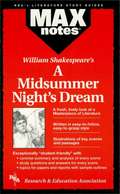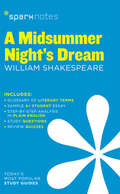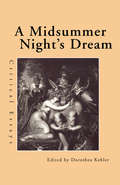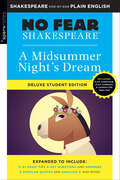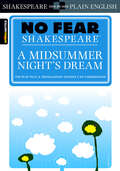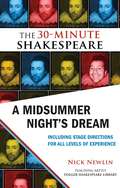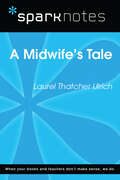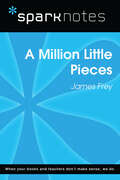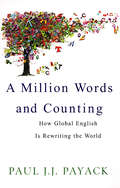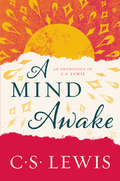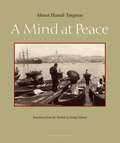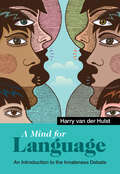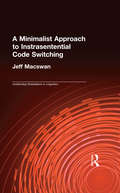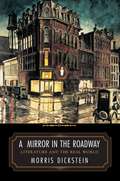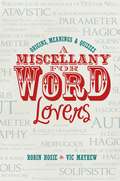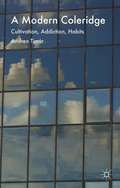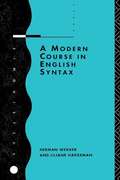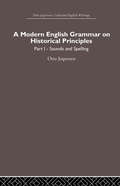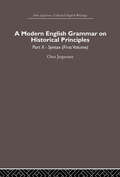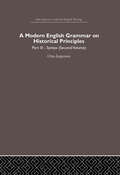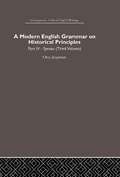- Table View
- List View
A Middle French Vowing Poem: A Middle French Vowing Poem (Routledge Revivals)
by Norris J. Lacy John L. GrigsbyPublished in 1992, this text discusses Les Voeux du Heron, a short text, comprising only 442 lines that was popular in the late Middle Ages but is virtually unknown today. This book includes and English translation, as well as a reconstruction of Manuscript U, published in its entirety for the first time.
A Midsummer Night's Dream
by William Shakespeare Mcdougal-Littell Publishing StaffShakespeare's comedy of lovers in the forest, with additional readings and supporting materials.
A Midsummer Night's Dream
by William ShakespeareFrom the hilarious mischief of the elf Puck to the rough humor of the self-centered Bottom and his fellow players, from the palace of Theseus in Athens to the magic wood where fairies play, Shakespeare's marvelous A Midsummer Night's Dream is a play of enchantment and an insightful portrait of the predicaments of love.
A Midsummer Night's Dream (MAXNotes Literature Guides)
by Gail RaeREA's MAXnotes for William Shakespeare's A Midsummer Night's Dream The MAXnotes offers a comprehensive summary and analysis of A Midsummer Night's Dream and a biography of William Shakespeare. Places the events of the play in historical context and discusses each act in detail. Includes study questions and answers along with topics for papers and sample outlines.
A Midsummer Night's Dream SparkNotes Literature Guide (SparkNotes Literature Guide Series #44)
by SparkNotesA Midsummer Night's Dream SparkNotes Literature Guide by William Shakespeare Making the reading experience fun! When a paper is due, and dreaded exams loom, here's the lit-crit help students need to succeed! SparkNotes Literature Guides make studying smarter, better, and faster. They provide chapter-by-chapter analysis; explanations of key themes, motifs, and symbols; a review quiz; and essay topics. Lively and accessible, SparkNotes is perfect for late-night studying and paper writing. Includes:An A+ Essay—an actual literary essay written about the Spark-ed book—to show students how a paper should be written.16 pages devoted to writing a literary essay including: a glossary of literary termsStep-by-step tutoring on how to write a literary essayA feature on how not to plagiarize
A Midsummer Night's Dream: Critical Essays (Shakespeare Criticism #19)
by Dorothea KehlerThis volume traces the modern critical and performance history of this play, one of Shakespeare's most-loved and most-performed comedies. The essay focus on such modern concerns as feminism, deconstruction, textual theory, and queer theory.
A Midsummer Night's Dream: No Fear Shakespeare Deluxe Student Editions - Shakespeare Side-by-Side Plain English (No Fear Shakespeare)
by William Shakespeare SparkNotesShakespeare everyone can understand—now in this new EXPANDED edition of MIDSUMMER NIGHT&’S DREAM! Why fear Shakespeare? By placing the words of the original play next to line-by-line translations in plain English, this popular guide makes Shakespeare accessible to everyone. And now it features expanded literature guide sections that help students study smarter. The expanded sections include: Five Key Questions: Five frequently asked questions about major moments and characters in the play. What Does the Ending Mean?: Is the ending sad, celebratory, ironic . . . or ambivalent? Plot Analysis: What is the play about? How is the story told, and what are the main themes? Why do the characters behave as they do? Study Questions: Questions that guide students as they study for a test or write a paper. Quotes by Theme: Quotes organized by Shakespeare&’s main themes, such as love, death, tyranny, honor, and fate. Quotes by Character: Quotes organized by the play&’s main characters, along with interpretations of their meaning.
A Midsummer Night's Dream: No Fear Shakespeare Side-by-Side Plain English (No Fear Shakespeare)
by William Shakespeare SparkNotesThis No Fear Shakespeare ebook gives you the complete text of A Midsummer Night's Dreamand an easy-to-understand translation.Each No Fear Shakespeare containsThe complete text of the original playA line-by-line translation that puts Shakespeare into everyday languageA complete list of characters with descriptionsPlenty of helpful commentary
A Midsummer Night's Dream: The 30-Minute Shakespeare
by Nick NewlinPlanning a school or amateur Shakespeare production? The best way to experience the plays is to perform them, but getting started can be a challenge: The complete plays are too long and complex, while scene selections or simplified language are too limited."The 30-Minute Shakespeare" is a new series of abridgements that tell the "story" of each play from start to finish while keeping the beauty of Shakespeare's language intact. Specific stage directions and character suggestions give even inexperienced actors the tools to perform Shakespeare with confidence, understanding, and fun!This cutting focuses on three ridiculously funny and vibrant scenes from A MIDSUMMER NIGHT'S DREAM. The first scene starts with Puck mistakenly anointing the eyes of the wrong lovers with love potion, leading to a madcap chase scene between Helena, Lysander, Hermia, and Demetrius. Scene two features Bottom's magical transformation to an ass, always an audience favorite. The final scene is the classic play within a play, where the "Rude Mechanicals" act out with "tragical mirth" the story of Pyramus and Thisbe, with specific comic suggestions for the characters, including Lion chasing Thisbe into the audience!The edition also includes an essay by editor Nick Newlin on how to produce a Shakespeare play with novice actors, and notes about the original production of this abridgement at the Folger Shakespeare Library's annual Student Shakespeare Festival.
A Midwife's Tale (SparkNotes Literature Guide Series)
by SparkNotesA Midwife's Tale (SparkNotes Literature Guide) by Laurel Thatcher Ulrich Making the reading experience fun! Created by Harvard students for students everywhere, SparkNotes is a new breed of study guide: smarter, better, faster. Geared to what today's students need to know, SparkNotes provides: *Chapter-by-chapter analysis *Explanations of key themes, motifs, and symbols *A review quiz and essay topicsLively and accessible, these guides are perfect for late-night studying and writing papers
A Million Little Pieces (SparkNotes Literature Guide Series)
by SparkNotesA Million Little Pieces (SparkNotes Literature Guide) by James Frey Making the reading experience fun! Created by Harvard students for students everywhere, SparkNotes is a new breed of study guide: smarter, better, faster. Geared to what today's students need to know, SparkNotes provides: *Chapter-by-chapter analysis *Explanations of key themes, motifs, and symbols *A review quiz and essay topicsLively and accessible, these guides are perfect for late-night studying and writing papers
A Million Words And Counting: How Global English Is Rewriting The World
by Payack Paul J.From Babel to Babble . . . Everyone is Speaking English In 2007, the English language passed the million-word mark. That shouldn't come as a surprise since over a billion Earthlings speak English (no one knows about other planets, but they probably speak it, too). That makes for a lot of word-coiners (neologists) out there. And where are all these new words coming from? Hollywood? Technology? The Internet? Corporate boardrooms? Youthspeak? How do world events--from tsunamis and hurricanes to political doublespeak and presidential linguistic bumbling--influence the words we use on a daily basis? What do e-mails, text messages, and emoticons contribute to the language? Let WordMan Paul J. J. Payack take you on a global tour of English-speaking worlds--virtual and otherwise: From India, Singapore, and China, to Australia, the U. S. and the U. K. From film, television, fashion, music, politics, sports, games, business, technology and science From TV junkies, fashionistas and sports fans, to amateur historians and linguists And from every other source that contributes to the global tapestry of English Get ready for a whirlwind tour of our increasingly global culture and how it becomes that way. A Million Words? Fundoo! Podcast, Chinglish, truthiness, crunk. Just a year or two ago, these words were gibberish to most English speakers. Today they pop up in everyday conversation worldwide, just four of the ten thousand new words added to the English language every year. Spurred by the universality of the Internet--where it is the de facto lingua franca--and the global reach of its media, English is growing at a rate unprecedented in its 1500-year history. Indeed, in the spring of 2007, the English word count surpassed a million--over ten times the number available in French. At the crest of this linguistic tsunami surfs Paul J. J. Payack, aka the WordMan. As president of the Global Language Monitor, he has tracked the latest developments--the fascinating hybrids, the bizarre etymologies, the lasting malapropisms--in the language shared by two billion of the Earth's citizens. Aided by a worldwide network of similarly obsessed language mavens and armed with his own powerful word-counting algorithm, Payack ensures that no new English word falls from the tongue or marks the page without being counted toward the Million Word March. A Million Words and Counting is a celebration of the vast variety and ever-evolving expressiveness of humanity's most universal language. Fun and informative, this guide is a joyful exploration of English as it spreads across the globe, as it is spoken today, and as it expands into the future. Each entertaining chapter of this ambitious linguistic survey examines another source of new English, including Hollywood, youth culture, other languages, corporate boardrooms, and tongue-tied presidents. An engaging compendium of English-language facts and factoids, this is a trivia lover's goldmine and a logophile's playground.
A Mind Awake: An Anthology of C. S. Lewis
by C. S. LewisA repackaged edition of the revered author’s anthology featuring hundreds of selections from his writings, organized by the main themes of Christian faith.C. S. Lewis—the great British writer, scholar, lay theologian, broadcaster, Christian apologist, and bestselling author of Mere Christianity, The Screwtape Letters, The Great Divorce, The Chronicles of Narnia, and many other beloved classics—wrote widely on all the main themes of Christian faith: God, Jesus, the Trinity, Scripture, sin, evil, nature, sex, the Christian life, prayer, faith, compassion, guilt, and forgiveness. A Mind Awake includes hundreds of short excerpts, curated from the full range of his works and organized them by theme. Useful as both a reference work and as a devotional resource, A Mind Awake contains hidden gems of wisdom that are provocative, whimsical, and insightful, and is an ideal introduction to this towering figure who has profoundly influenced modern Christianity.
A Mind at Peace
by Erdag Goknar Ahmet Hamdi TaniparSurviving the childhood trauma of his parents' untimely deaths in the early skirmishes of World War I, Mümtaz is raised and mentored in Istanbul by his cousin Ihsan and his cosmopolitan family of intellectuals. Having lived through the tumultuous cultural revolutions following the fall of the Ottoman Empire and the rise of the early Turkish Republic, each is challenged by the difficulties brought about by such rapid social change.The promise of modernization and progress has given way to crippling anxiety rather than hope for the future. Fragmentation and destabilization seem the only certainties within the new World where they now find themselves. Mümtaz takes refuge in the fading past, immersing himself in literature and music, but when he falls in love with Nuran, a complex woman with demanding relatives, he is forced to confront the challenges of the World at large. Can their love save them from the turbulent times and protect them from disaster, or will inner obsessions, along with powerful social forces seemingly set against them, tear the couple apart?A Mind at Peace, originally published in 1949 is a magnum opus, a Turkish Ulysses and a lyrical homage to Istanbul. With an innate awareness of how dueling cultural mentalities can lead to the distress of divided selves, Tanpinar gauges this moment in history by masterfully portraying its register on the layered psyches of his Istanbulite characters.
A Minimalist Approach to Intrasentential Code Switching (Outstanding Dissertations in Linguistics)
by Jeff MacSwanFirst Published in 1999. Code switching is widely used in bilingual communities worldwide, and has been found in government documents, literature, religious works, and song. Pursuing this aim here, chapter 1 addresses the relevance of the study of code switching for education and schooling, focusing on ways in which a misunderstanding of code switching may lead to tacit tracking effects for language-minority children.
A Minimalist Theory of Simplest Merge (Routledge Leading Linguists)
by Samuel D. Epstein Hisatsugu Kitahara T. Daniel SeelyThis collection explicates one of the core ideas underpinning Minimalist theory – explanation via simplification – and its role in shaping some of the latest developments within this framework, specifically the simplest Merge hypothesis and the reduction of syntactic phenomena to third factor considerations. Bringing together recent papers on the topic by Epstein, Kitahara, and Seely, with one by Epstein, Seely and Obata, and one by Kitahara, the book begins with an introduction which situates the papers in a cohesive overview of some of the latest research on Minimalism, as facilitated by current theoretical developments. The volume integrates a historical overview of evolutions in Merge, starting with Chomsky’s (pre-Merge) Aspects model up to current theoretical models, including a primer of Chomsky’s most recent theory of Merge based on the concept of Workspace. The Minimalist notions of "perfection" and "simplification" are also outlined, providing clearly explicated coverage of key technical concepts within the framework as applied to grammatical phenomena. Taken as a whole, the collection both introduces and advances Minimalist theory for students and scholars in linguistics and related sub-disciplines of psychology, philosophy, and cognitive science, as well as offering new directions for future research for researchers in these fields.
A Mirror in the Roadway: Literature and the Real World
by Morris DicksteinIn a famous passage in The Red and the Black, the French writer Stendhal described the novel as a mirror being carried along a roadway. In the twentieth century this was derided as a naïve notion of realism. Instead, modern writers experimented with creative forms of invention and dislocation. Deconstructive theorists went even further, questioning whether literature had any real reference to a world outside its own language, while traditional historians challenged whether novels gave a trustworthy representation of history and society.In this book, Morris Dickstein reinterprets Stendhal's metaphor and tracks the different worlds of a wide array of twentieth-century writers, from realists like Theodore Dreiser, Sinclair Lewis, Edith Wharton, and Willa Cather, through modernists like Franz Kafka and Samuel Beckett, to wildly inventive postwar writers like Saul Bellow, Günter Grass, Mary McCarthy, George Orwell, Philip Roth, and Gabriel García Márquez. Dickstein argues that fiction will always yield rich insight into its subject, and that literature can also be a form of historical understanding. Writers refract the world through their forms and sensibilities. He shows how the work of these writers recaptures--yet also transforms--the life around them, the world inside them, and the universe of language and feeling they share with their readers.Through lively and incisive essays directed to general readers as well as students of literature, Dickstein redefines the literary landscape--a landscape in which reading has for decades been devalued by society and distorted by theory. Having begun with a reconsideration of realism, the book concludes with several essays probing the strengths and limitations of a historical approach to literature and criticism.
A Miscellany for Word Lovers: Origins, Meanings & Quizzes
by Robin Hosie Vic MayhewMore than 100 vocabulary-building quizzes make up the core of the book, with shorter sections on: * The fascinating origins of words * Quotes and misquotes* Slang, dialects and secret languages * Unforgettable Adverts, Famous Lines from Novels and Movies* Newspeak, Basic English, spelling reform* Malapropisms, politicians' blunders and 'mispeakings'* Mnemonics and other memory joggers* Palindromes and anagrams * Semaphore. Morse, tic-tac, hand gestures and other ways of speaking without wordsEntry after entry explores the byways, oddities and curiosities of the English language.
A Modern Coleridge
by Andrea TimárA Modern Coleridge shows the interrelatedness of the discourses of cultivation, addiction and habit in Coleridge's poetry and prose, and argues that these all revolve around the problematic nexus of a post-Kantian idea of free will, essential to Coleridge's eminently modern idea of the 'human'.
A Modern Course in English Syntax
by Liliane Haegeman Herman WekkerThis popular course book gives students of English and linguistics a systematic account of the rules of English syntax, and acquaints them with the general methodology of syntactic description. It teaches them how to formulate syntactic arguments, and how to apply the tests in the analysis of sentences.
A Modern English Grammar on Historical Principles: Volume 1, Sounds and Spellings
by Otto JespersenThis book was first published in 1954, A Modern English Grammar on Historical Principles is a valuable contribution to the field of English Grammar and Linguistics.
A Modern English Grammar on Historical Principles: Volume 2, Syntax (first volume)
by Otto JespersenThis book was first published in 1954, A Modern English Grammar on Historical Principles is a valuable contribution to the field of English Language and Linguistics.
A Modern English Grammar on Historical Principles: Volume 3
by Otto JespersenThis book was first published in 1954, A Modern English Grammar on Historical Principles is a valuable contribution to the field of English Grammar and Linguistics.
A Modern English Grammar on Historical Principles: Volume 4. Syntax (third volume)
by Otto JespersenThis book was first published in 1954, A Modern English Grammar on Historical Principles is a valuable contribution to the field of English Language and Linguistics.
